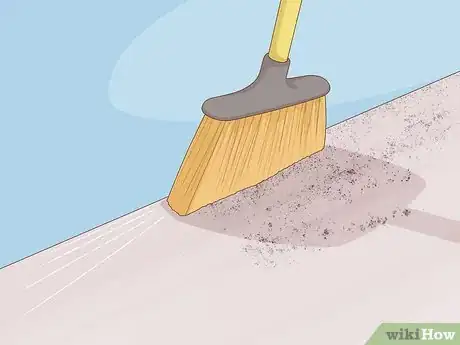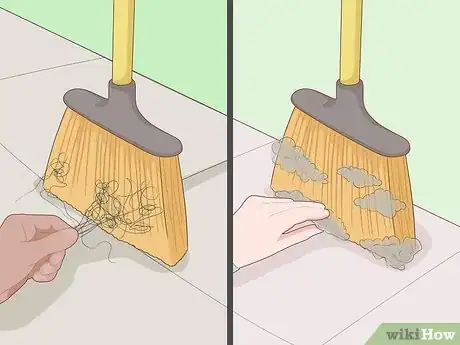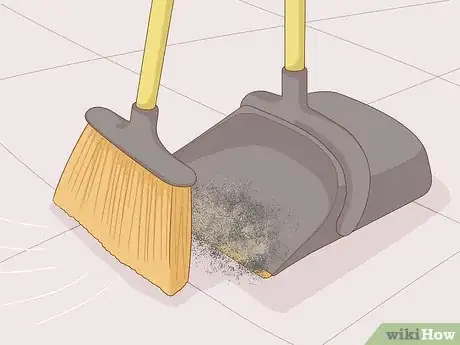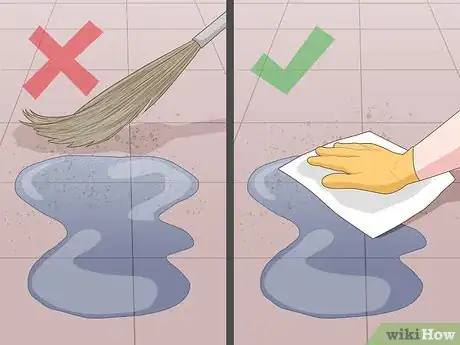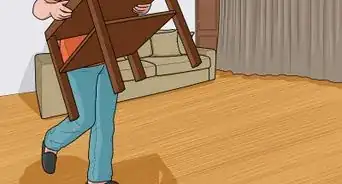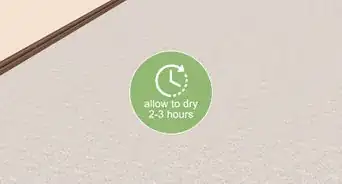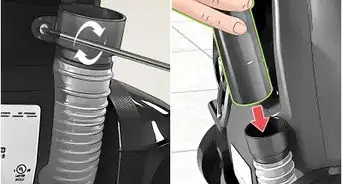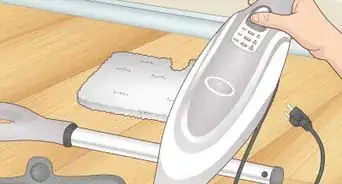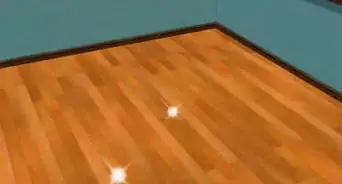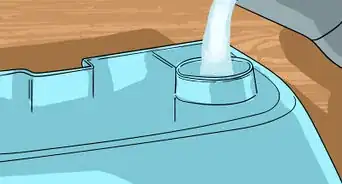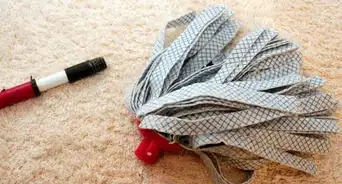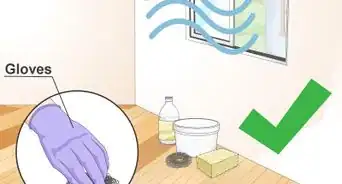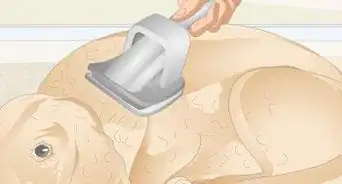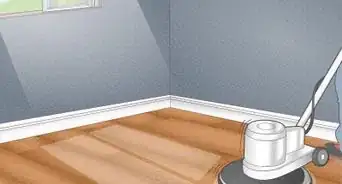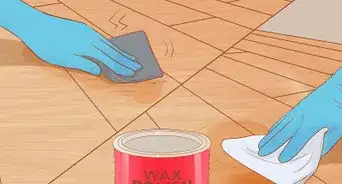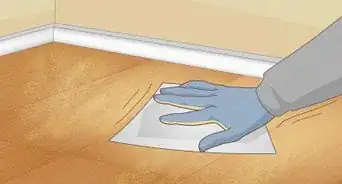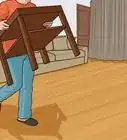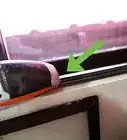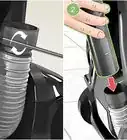This article was co-authored by Guy Peters. Guy Peters is the Owner of MOP STARS Cleaning Service, a complete house cleaning service for residential and commercial clients, based in Denver, Colorado. Founded in 2014, MOP STARS provides regular, move in/out, deep, and commercial cleaning services. Guy has a BA in Finance from the California State University - Sacramento and an MBA from Cornell University.
There are 8 references cited in this article, which can be found at the bottom of the page.
This article has been viewed 330,595 times.
Sweeping floors keeps them free of unsightly and unhygienic dust and debris, and is often the first step in more extensive cleaning projects. While sweeping may seem like a common sense task to most people, there is a right and a wrong way to do it. Learning a few simple tricks like selecting the type of broom that’s most suitable for the floor you’re sweeping and working your way from the edges of the room inward will help you make short work of the chore and let you get back to enjoying your day.
Steps
Sweeping Efficiently
-
1Drag the head of the broom along the ground using short, deliberate strokes. Hold the broom in both hands, with one hand at the top and the other near the middle, and move it from the outside of your body inward. As you do, the bristles will push whatever kind of detritus that’s found its way onto the floor in the direction you’re sweeping.[1]
- The shorter your strokes, the more control you’ll have. The idea is to get all of the debris into one central place, not just whisk it around aimlessly.
- Resist the urge to sweep too fast or too forcefully. Doing so can send clouds of dust billowing up, only to settle back down on the section you just swept.
-
2Start at the edges of the room and work your way towards the center. Draw the debris away from the baseboards and out into the open, where you can shape it into a small pile that will be easy to collect later on.[2] You may need to angle your broom when you get to corners, cabinet bottoms, or low-lying pieces of furniture to make sure that the bristles reach back into the deepest recesses.[3]
- It’s also a good idea to proceed from the far side of the room towards the door or entrance. That way, you won’t be forced to track back through the crud that’s lying around.[4]
- For particularly large rooms, try dividing the floor up into smaller sections and treating each section like a self-contained space.[5]
Advertisement -
3Pause periodically to clean your broom. Items like hair, lint, and dust bunnies have a tendency to get caught in broom bristles. When this happens, hold the broom over a trash can and loosen the stuck-on substances by hand. You can then get back to sweeping without having to worry about transferring the mess to another part of the floor.[6]
- Make sure you wash your hands after handling anything that’s been on the floor.
-
4Sweep the pile you’ve been forming into your dustpan for disposal. Once you’ve gone around the edges of the room, turn your attention towards coaxing the accumulated debris into your dustpan.[7] Then, pick up the dustpan carefully, empty the contents into the nearest trash receptacle, and call it a day![8]
- Consider switching to a compact hand sweeper at this point to manipulate small piles with greater precision.[9]
Tip: Shortening your strokes and applying lighter pressure with the bristles will help you get more debris into your dust pan.
-
5Use the “drawbridge” technique to deal with annoying dustpan lines. Sometimes after sweeping a pile of debris into your dustpan, you’ll notice a thin line of dust left behind at the front edge. When this happens, raise the handle up at a steep angle while keeping the lip pressed firmly into the floor. This will allow you to brush the dust up over the threshold before “lowering the drawbridge” and trapping it in the dustpan.[10]
- This method is especially useful if the dustpan you’re using has a lip that’s too thick to let dust and smaller pieces of debris pass over easily.
- Alternatively, you can simply vacuum or wipe up dust lines that you’re having difficulty corralling with your broom.[11]
Simplifying Sweeping
-
1Restrict yourself to hard floors. First thing’s first—if the surface you’re attempting to clean is wood, tile, laminate, stone, concrete, marble, metal, or another solid material, go ahead and sweep your heart out. Carpet, rugs, and upholstery will need to be vacuumed instead.[12]
- You can also run a vacuum cleaner with a "hard floors" setting over most solid types of flooring to tidy up in less time.[13]
- For less common flooring materials, such as bamboo, cork, or thatch, you have the option of either sweeping or vacuuming. Go with whichever method you think will offer the best results.
-
2Clear the area of any possible obstructions. Before you get started, take a moment to remove or relocate any objects from your path that might slow you down or make it harder to work. This includes things like furniture, decorations, throw rugs, and the kind of miscellaneous clutter that often ends up on the floor.[14]
- Take rugs and other floor coverings outside and shake them out thoroughly to prevent them from shedding dust onto your freshly-swept floor once you’re ready to replace them.
- When sweeping around tables, push the chairs back to make it easier to get underneath the table with your broom.
-
3Clean up wet messes before you sweep. If you’ve got a spill on your hands, break out the mop or grab a roll of paper towels. Brooms are best suited for gathering up small pieces of dry debris, such as dust, dirt, hair, crumbs, and bits of broken items. They won’t be much help on puddles, splatters, and the like.[15]
- Trying to sweep up liquids or soft, runny foods will only spread the mess to other parts of the floor, and could even ruin your broom’s bristles.
-
4Choose an appropriate broom for the area you’re sweeping. A standard straight-knit fiber broom will work just fine for sweeping most floors. However, you might be better off using a push broom with a broad head if you’ve got a lot of ground to cover. Likewise, soft dust mops are handy for attracting dust in large, open indoor areas like hallways, offices, and gymnasiums.
- Not all brooms are made alike. Different brooms have different head shapes, handle lengths, and bristle materials, all of which have an impact on the way they clean.
- Unless you’re sweeping an outdoor area, you’ll also need a dustpan. These days, most brooms come packaged with dustpans for the sake of convenience, but you can pick one up for just a few dollars if you don’t have one already.[16]
Tip: Natural fiber bristles tend to do a better job of cleaning textured surfaces like wood, concrete, and brick, while synthetic bristles glide effortlessly over smoother floors.
Expert Q&A
-
QuestionHow do you sweep without stirring up dust?
 Guy PetersGuy Peters is the Owner of MOP STARS Cleaning Service, a complete house cleaning service for residential and commercial clients, based in Denver, Colorado. Founded in 2014, MOP STARS provides regular, move in/out, deep, and commercial cleaning services. Guy has a BA in Finance from the California State University - Sacramento and an MBA from Cornell University.
Guy PetersGuy Peters is the Owner of MOP STARS Cleaning Service, a complete house cleaning service for residential and commercial clients, based in Denver, Colorado. Founded in 2014, MOP STARS provides regular, move in/out, deep, and commercial cleaning services. Guy has a BA in Finance from the California State University - Sacramento and an MBA from Cornell University.
House Cleaning Professional Always use smaller, shorter strokes. Not only will these be more precise, but they also won’t make a mess in the process of sweeping. Trying to go too quickly with big strokes will end pushing dust and debris around the room.
Always use smaller, shorter strokes. Not only will these be more precise, but they also won’t make a mess in the process of sweeping. Trying to go too quickly with big strokes will end pushing dust and debris around the room. -
QuestionHow can I sweep more efficiently?
 Guy PetersGuy Peters is the Owner of MOP STARS Cleaning Service, a complete house cleaning service for residential and commercial clients, based in Denver, Colorado. Founded in 2014, MOP STARS provides regular, move in/out, deep, and commercial cleaning services. Guy has a BA in Finance from the California State University - Sacramento and an MBA from Cornell University.
Guy PetersGuy Peters is the Owner of MOP STARS Cleaning Service, a complete house cleaning service for residential and commercial clients, based in Denver, Colorado. Founded in 2014, MOP STARS provides regular, move in/out, deep, and commercial cleaning services. Guy has a BA in Finance from the California State University - Sacramento and an MBA from Cornell University.
House Cleaning Professional Start from the outside in and make small piles. You don’t want to try and move dirt too far around the room, and many small piles will typically be more effective than trying to create one big pile.
Start from the outside in and make small piles. You don’t want to try and move dirt too far around the room, and many small piles will typically be more effective than trying to create one big pile. -
QuestionHow often should you clean a broom?
 Guy PetersGuy Peters is the Owner of MOP STARS Cleaning Service, a complete house cleaning service for residential and commercial clients, based in Denver, Colorado. Founded in 2014, MOP STARS provides regular, move in/out, deep, and commercial cleaning services. Guy has a BA in Finance from the California State University - Sacramento and an MBA from Cornell University.
Guy PetersGuy Peters is the Owner of MOP STARS Cleaning Service, a complete house cleaning service for residential and commercial clients, based in Denver, Colorado. Founded in 2014, MOP STARS provides regular, move in/out, deep, and commercial cleaning services. Guy has a BA in Finance from the California State University - Sacramento and an MBA from Cornell University.
House Cleaning Professional Take breaks to clean your broom during your sweeping, since it’s easy for dust and debris to get stuck in the bristles. This dust and debris can occasionally fall off the bristles and end up making a mess.
Take breaks to clean your broom during your sweeping, since it’s easy for dust and debris to get stuck in the bristles. This dust and debris can occasionally fall off the bristles and end up making a mess.
Things You’ll Need
Preparing Your Floor
- Broom
- Dustpan
- Trash receptacle
- Hand sweeper (optional)
- Vacuum (optional)
- Mop (optional)
- Paper towels (optional)
References
- ↑ https://www.popsci.com/scientifically-best-way-to-sweep-floor/
- ↑ Guy Peters. House Cleaning Professional. Expert Interview. 12 July 2021.
- ↑ http://www.oprah.com/home/the-best-way-to-sweep-a-floor-and-other-housekeeping-tips/all
- ↑ Guy Peters. House Cleaning Professional. Expert Interview. 12 July 2021.
- ↑ https://www.popsci.com/scientifically-best-way-to-sweep-floor/
- ↑ https://www.remodelista.com/posts/domestic-science-how-to-sweep-a-floor/
- ↑ Guy Peters. House Cleaning Professional. Expert Interview. 12 July 2021.
- ↑ https://www.youtube.com/watch?v=Kt-VlZpz-8E&feature=youtu.be&t=103
- ↑ https://www.remodelista.com/posts/domestic-science-how-to-sweep-a-floor/
- ↑ https://www.remodelista.com/posts/domestic-science-how-to-sweep-a-floor/
- ↑ https://www.popsci.com/scientifically-best-way-to-sweep-floor/
- ↑ https://www.nytimes.com/guides/smarterliving/how-to-clean
- ↑ https://www.architypes.net/flooring/hardwood/sweep-or-vacuum/
- ↑ http://www.oprah.com/home/the-best-way-to-sweep-a-floor-and-other-housekeeping-tips/all
- ↑ https://www.realsimple.com/home-organizing/cleaning/cleaning-kitchen/fixes-kitchen-spills
- ↑ https://www.remodelista.com/posts/domestic-science-how-to-sweep-a-floor/
About This Article
Before you sweep a floor, remove any furnishings, rugs, toys, or shoes from the area where you want to sweep. Start in one edge or corner of the room and sweep in overlapping strokes toward the center of the room. Work your way around the room, sweeping dust and dirt into a neat pile. When you’re finished, carefully sweep the dirt pile into a dustpan and dispose of it in the wastebasket. Keep reading to learn how to choose the right broom for the job!
